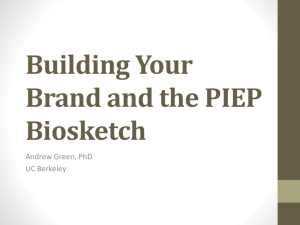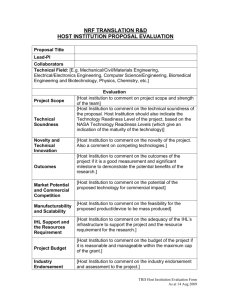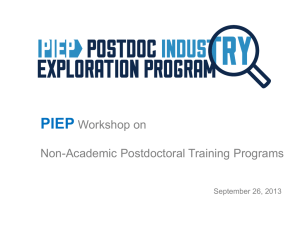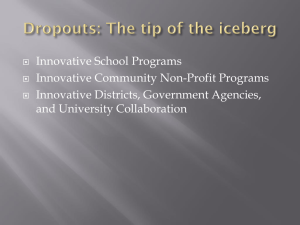product innovation engineering program
advertisement
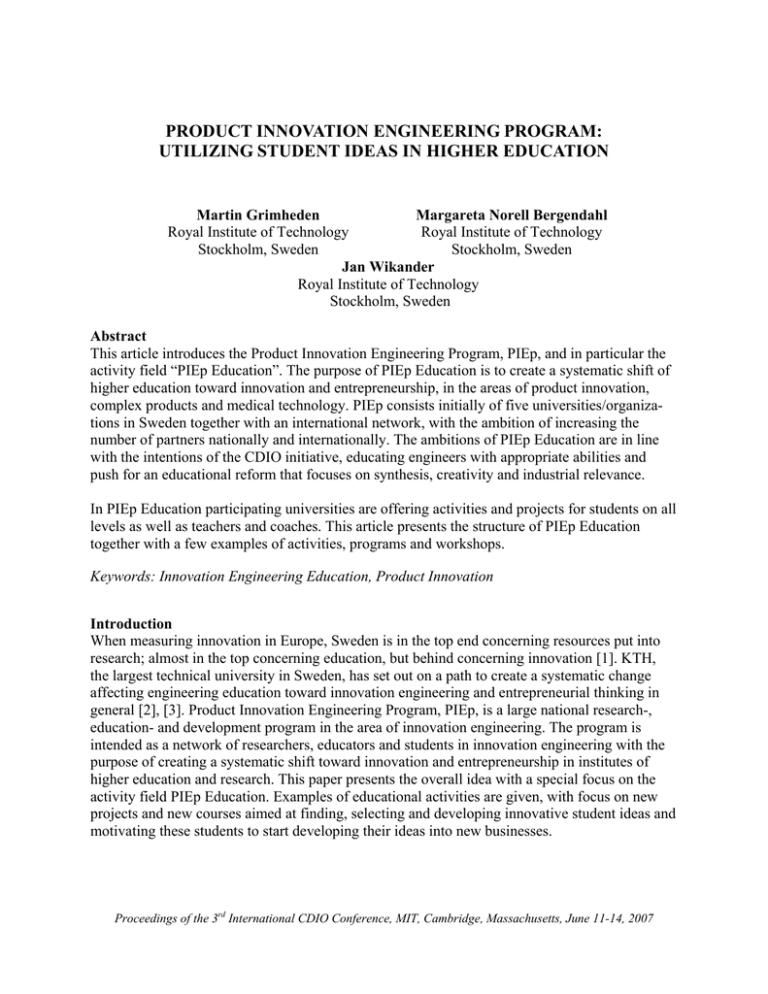
PRODUCT INNOVATION ENGINEERING PROGRAM: UTILIZING STUDENT IDEAS IN HIGHER EDUCATION Martin Grimheden Margareta Norell Bergendahl Royal Institute of Technology Royal Institute of Technology Stockholm, Sweden Stockholm, Sweden Jan Wikander Royal Institute of Technology Stockholm, Sweden Abstract This article introduces the Product Innovation Engineering Program, PIEp, and in particular the activity field “PIEp Education”. The purpose of PIEp Education is to create a systematic shift of higher education toward innovation and entrepreneurship, in the areas of product innovation, complex products and medical technology. PIEp consists initially of five universities/organizations in Sweden together with an international network, with the ambition of increasing the number of partners nationally and internationally. The ambitions of PIEp Education are in line with the intentions of the CDIO initiative, educating engineers with appropriate abilities and push for an educational reform that focuses on synthesis, creativity and industrial relevance. In PIEp Education participating universities are offering activities and projects for students on all levels as well as teachers and coaches. This article presents the structure of PIEp Education together with a few examples of activities, programs and workshops. Keywords: Innovation Engineering Education, Product Innovation Introduction When measuring innovation in Europe, Sweden is in the top end concerning resources put into research; almost in the top concerning education, but behind concerning innovation [1]. KTH, the largest technical university in Sweden, has set out on a path to create a systematic change affecting engineering education toward innovation engineering and entrepreneurial thinking in general [2], [3]. Product Innovation Engineering Program, PIEp, is a large national research-, education- and development program in the area of innovation engineering. The program is intended as a network of researchers, educators and students in innovation engineering with the purpose of creating a systematic shift toward innovation and entrepreneurship in institutes of higher education and research. This paper presents the overall idea with a special focus on the activity field PIEp Education. Examples of educational activities are given, with focus on new projects and new courses aimed at finding, selecting and developing innovative student ideas and motivating these students to start developing their ideas into new businesses. Proceedings of the 3rd International CDIO Conference, MIT, Cambridge, Massachusetts, June 11-14, 2007 Background - Changing contexts Innovation Engineering can be interpreted both as an ability to create conditions for innovation, and also as innovative power in developing engineering products. The industrial history in Sweden can be characterized by a number of manufacturing companies that has grown to multinational corporations based mainly on technical innovations, with the examples of Volvo, SKF, Ericsson and Scania. The position is though challenged; several of the major companies have been acquired by international actors and the global competition forces decisions conveying that both activities and competencies disappear from Sweden. In a situation where work and related competence within production technology is transferred a worrisome development would be that also activities related to development are transferred to countries where the production now takes place. It is also a fact that many of the larger Swedish corporations stem from innovations made many years ago, companies like Ericsson, ABB, Scania and others [4]. According to the Swedish Patent and Registrations Office [5] the number of patent applications decreased in Sweden with 42% between 2000 and 2006. No clear explanation to the decrease is found, and the need to investigate further is apparent. The potential to develop new businesses is closely related to an increased ability in innovative product development, and to develop innovative organizations, processes and people with capacity in creating value through new products and services [6],[7]. Introducing PIEp, Product Innovation Engineering Program PIEp is a national program that addresses and performs increased Swedish ability in innovative product- and business development. The potential to keep and develop possibilities of new businesses is closely related to the success in increasing the ability in innovative product and business development, which involves the development of innovative organizations, processes and people with capacity to create value through new products and services. The PIEp program encompasses the field from theory to practice, from research in innovation to directed activities aimed at strengthening Swedish innovative product development. The PIEp program was launched in late 2006 by a consortium consisting of five initial Swedish PIEp nodes with the ambition to add more national and international nodes. Among the initial financiers are VINNOVA (The Swedish Governmental Agency for Innovation Systems), Innovationsbron AB (A Swedish business development agency) and individual sponsors. The initial PIEp consortium The PIEp consortium currently consists of members from a national PIEp network spanning relevant research groups and representatives of application specific areas. The network consists initially of the following five nodes, each bringing its respective specialties to be utilized in the PIEp network: • Faculty of Engineering, Lund University. o Research and education in the design sciences with need analysis, design methods and design principles. Also, ergonomics and industrial design. o Innovation research. Proceedings of the 3rd International CDIO Conference, MIT, Cambridge, Massachusetts, June 11-14, 2007 • • • • o Ideon Science Park, with extensive experience from utilizing academic research and from several success stories. Umeå Institute of Design, Umeå University o Extensive experiences from research and education in user-oriented design, interactive design and product design in general. o Industrial collaborative research and educational projects with partners such as ABB, Ericsson, Telia and Volvo. International Business School and School of Engineering at Jönköping University o Jönköping Science Park, with extensive experience from SMEs. o School of Engineering, Jönköping University, educating directly to and for SMEs. o International Business School with research and education in entrepreneurship, business renewal and internationalization. KTH, Royal Institute of Technology, School of Industrial Technology and Management o Research and education in innovative and integrated product development, and industrial engineering and management. o Research and education in complex, knowledge intensive products and systems development, in particular related to medical engineering, mechatronics and embedded systems. CTMH, Center for Technology, Medicine and Health o Multidisciplinary research and education in innovation and entrepreneurship in medical engineering The five nodes are chosen to contribute to the overall goal of creating possibilities for a systematic change of abilities in innovative product development. The area of design is identified as an important factor in product development, and the partner Umeå Institute of Design is the leading institute in Sweden. The roles of SMEs are equally identified as important for entrepreneurship, and the Jönköping University node is situated in the midst of one of the main SME regions of Sweden. Ideon Research Park in the vicinity of Lund University is a meeting place for researchers, entrepreneurs, innovators and educators suitable for studies of start-ups, incubators and business mentoring. CTMH provides the platform for the application specific domain – medical technology, with extensive experience from innovation and entrepreneurship in this area. KTH provides both research groups in innovative product development and in the application specific domain, related to development of complex, knowledge intensive products (mechatronic products). KTH also has existing networks with STING (Stockholm Innovation and Growth) which provides a well established and efficient environment for new entrepreneurs and start-up companies as well as SSES (Stockholm School of Entrepreneurship) with educational programs and networks for entrepreneurs. PIEp Innovation Network – PIEp Innovation Friends In the development phase of the PIEp program a number of national and international partners have contributed in the design and establishment of the program and consortium. These nodes together with a few partners from previous collaboration with members of the consortium constitute an interim PIEp innovation network, sometimes referred to as belonging to the PIEp Innovation Friends. The initial network consists of members from Stanford University, Boston University, Harvard Medical School, TU Delft, Zheijang University, Technical University of Denmark and the Swiss Federal institute of Technology in Zurich. These members represent Proceedings of the 3rd International CDIO Conference, MIT, Cambridge, Massachusetts, June 11-14, 2007 international expertise in product development, engineering design and product innovation. More members of the international network are however needed to fully cover the necessary areas of competence. The PIEp Program PIEp is implemented with a series of activities: research efforts, educational efforts and development projects. The research efforts are necessary to gather existing, and generate new, knowledge about the innovator, the innovation process and the innovation system. Further, PIEp contributes to technical research efforts which are governed not only by the scientific questions, but also more directly from a product and innovation oriented perspective. The innovation climate in participating companies is developed through research, development and directed activities such as creative sessions and the building of networks. The program spans the area of product innovation engineering, from theory to practice and from research to innovative product development. The program is organized in five fields; two with a focus on process and organization oriented research (Innovation Knowledge and Innovation Management), two related to product- and business oriented research and development (Innovation Experience and Innovation Business) and one related to education (PIEp Education). All five fields generate knowledge and feed back knowledge and experiences to the other fields. Innovation Knowledge New products New companies Innovation Business Models for assessing innovative cabability PIEp EDU Rotation programs PIEp Trainee Creative sessions Learning networks Research in innovation, Research for innovation Innovation Management Implementation and evaluation of innovation models Innovation Experience Figure 1: PIEp is illustrated with a ‘learning cycle’ to show how the five fields are related, with PIEp Education as the central activity – nourished from the outer five fields and providing ideas, material, students etc. to the other fields. The engineering students today are the innovative engineers of tomorrow. Influence on education in innovation is performed within undergraduate, graduate and postgraduate education. Influence on education and the enhanced innovation climate will together with leading high technology research and development lead to new products and new businesses. This process is further Proceedings of the 3rd International CDIO Conference, MIT, Cambridge, Massachusetts, June 11-14, 2007 strengthened by means of a series of catalytic activities such as a trainee program, projects for increased mobility between academy and industry as well as entirely new courses and programs in innovation engineering. Innovation Knowledge constitutes the kick-start of the program; a large research effort with the purpose to create a base for the rest of the program. Innovation Management involves mainly action research aimed at performing change and effect upon participating companies, and to utilize research performed in Innovation Knowledge. Innovation Experience is built on a forum where knowledge and skills in innovation are utilized for participating partners; where innovators meet and where companies find a creative ground for innovative sessions with creative people and organizations. Innovation Experience also involves rotational programs between industry and academy and international collaborative programs. Innovation Business is built on activities aimed at utilizing research results, student projects, ideas etc. into products and businesses. Further, Innovation Business feeds back into Innovation Knowledge where new knowledge is gathered based on experiences and results from all other fields. PIEp Education is the field that utilizes and feeds knowledge and skills to and from all other fields. Innovation Business, for example, utilizes student ideas and creates products and businesses from student projects. PIEp Education is nourished from the activities in Innovation Experience, Innovation Knowledge and Innovation Experience that provide information for courses in innovation. Examples of activities in PIEp Education are new courses in innovation, a graduate school for doctoral students, exchange programs for students, rotational programs for faculty, better utilization of all existing mechanisms for bringing an idea to the market, and technical research education driven by scientific and business oriented merits in symbiosis. Figure 1 shows an illustration of the ‘learning cycle’ of PIEp together with some keywords and key activities of the respective activity fields [8],[9]. Product focus There are many examples of good technical inventions that so far have not lead to a considerable commercial activity. In Sweden, we have seen a recent example with the communicational standard STDMA. There are also many examples where successful companies and economic growth appeared in other countries than where the invention originated. There are always ideas, concepts, initial experiments and prototypes with the potential of becoming products that generates work, employment and growth. These ideas should result in an increased number of products or product concepts within companies, undergraduate and graduate education, leading to sustainable business and growth. PIEp should also contribute to the satisfaction of known needs by way of new products and companies, and that unknown needs are identified and fulfilled by appropriate solutions, e.g. with new products for elderly and disabled. The industry-specific strategic programs defined by government bodies that have been developed within different fields are important, and PIEp is an urgent complement that addressed crossindustrial innovative capability. The knowledge in innovative development that will be gathered, developed and used in PIEp should be applicable in a wide range of products and markets. Innovation engineering is a generic and strategic competence. Knowledge, methods and instruments will be useable for both Proceedings of the 3rd International CDIO Conference, MIT, Cambridge, Massachusetts, June 11-14, 2007 small and large companies, and the implementation will be adapted to the varying needs of the different companies. PIEp focuses on the development of complex, knowledge-intensive products. Within the PIEp framework, research and development will be performed both within the areas of health and medical technology, as well as within activities and businesses related to Swedish advanced technology companies, both existing and new. PIEp is focused on innovation in the development of products and services with a physical carrier. Possible innovations could be found in technical development, in how to utilize academic research in product development, in service design and in business development. It is most necessary to address the entire product life cycle in an integrated perspective, even if the research efforts in PIEp mainly addresses the early phases in the product development process. Knowledge that is generated in PIEp will typically be applicable also in development of pure service products [10],[11]. PIEp Education PIEp Education is nourished from activities in other PIEp activity fields, such as the fields of Innovation Experience and Innovation Knowledge where innovators and researchers in innovation collaborate and contribute. Activities in PIEp Education involves new courses in innovation, a graduate school for doctoral students, exchange programs for students, rotational programs for faculty and better utilization of all existing mechanisms for bringing ideas to the market. The aim of PIEp Education is to lead and support a systematic shift of higher engineering education, toward innovation and entrepreneurship, and the mechanisms for this shift is applied on all levels in the engineering structure. PIEp Education is organized with coordinators at each participating node, jointly constituting the PIEp Education Executive group. Figure 2 below illustrates the three focus groups and some of the planned activities of PIEp Education. The following sections intend to present briefly a number of existing or planned projects of PIEp Education. Proceedings of the 3rd International CDIO Conference, MIT, Cambridge, Massachusetts, June 11-14, 2007 PIEp EDUCATION BSc and MSc Courses in Innovation Engineering Global Master Thesis Projects PhD Graduate School Mobility programs PIEp Master International exchange Scholarships Business driven PhD PIEp Doctor Industrial rotation programs Teaching and coaching Mobility Networks Workshops Coaching courses International exchange Figure 2: PIEp Coach Illustration of PIEp Education with projects and activities focuses on different levels of the educational structure. PIEp Master - examples of activities on BSc and MSc level Activities and projects on BSc and MSc level are divided into local, national and international activities. The coordinators at the PIEp nodes are each responsible for local activities such as new courses and programs in innovation engineering. The national and international activities are aimed at all students at all participating nodes and the responsibilities for those are shared among the nodes and coordinated by the PIEp Education management group. Through PIEp mechanisms, students are offered scholarships to study abroad, at international collaborating partners. Students are offered participation in national alumni programs (students as actors of change). PIEp Education further organizes innovation competitions, collaborates with existing organizations such as business development organizations and provides links between existing student programs and innovation mechanisms such as venture capital organizations, seed financiers and business incubators. More detailed examples of activities are: A first course in Product Innovation Engineering This pilot course was launched at KTH in August 2006, and the basic idea of this first course is to provide students with an attractive alternative to applying for a job immediately after graduation – to provide students with guidance toward entrepreneurship. Students are recruited during their final year of studies, before the process of searching for a job has commenced. Proceedings of the 3rd International CDIO Conference, MIT, Cambridge, Massachusetts, June 11-14, 2007 Typically, the students aimed for are either finishing their final courses, searching for a thesis project or currently undertaking a thesis project. The students are recruited from areas related to product development. The students are asked to present an idea for a product or a business. This idea is put in front of a selection team consisting of representatives from the university, from industrial companies, from business coaches and seed capital representatives. Students are then accepted on basis of the potential of their respective ideas, and the course is based on the process of taking the ideas into products and onto the market. The ideas are each judged according to the knowledge base of the student as well as the faculty. The students are required to put forward an idea that correlates to his or her specialization, and the idea is required to be based on knowledge and skills within this field. The field is also required to correlate with the fields of the faculty, meaning that the faculty is able to provide guidance within this field. Typically, the ideas are expected to have sprung from student projects related to capstone courses, master thesis projects or student projects in general. Phase 1 Focus: Innovation Activities: Idea selection Technology Patent searches Brainstorming Deliverables: Prototype design Idea development State-of-the-art review Business models Patent Phase 2 Focus: Market Business Theme: From business establishment and development to entrepreneurship Actors: Business coaches Incubators Business angels Seed capital Deliverables: Figure 3: Business plan Business Illustration of the structure of the pilot course. The course is based on two phases. Each phase corresponds to one semester. National and international collaborative projects Students from the participating universities are offered to participate in national and international product development projects with the purpose of creating networks and synergistic integration Proceedings of the 3rd International CDIO Conference, MIT, Cambridge, Massachusetts, June 11-14, 2007 of competencies. An example of these projects is the setup of a national Swedish student team with one-two students from each participating university, combining expertise in complex product development, user oriented design, design methodology, mechatronics and business development. This team further collaborates with a student team at Stanford University, with a corporate sponsor who provides an industrial project. The Swedish students participate as master thesis students, each specializing in his or her area of competence. PIEp further provides global coaching for the students and provides mobility funding for student travels. The students are expected to keep their relations to their “home universities”, bringing back experiences and competence to other students and local community. These collaborative projects are intended to be launched in late 2007. Thesis projects, scholarships and competitions An important aspect of PIEp is the idea of encouraging student ideas early and to promote networks and bridges between entrepreneurs, industry and academia. Through PIEp, industrial sponsors are offered the opportunity to propose thesis projects to students, to offer scholarships to innovative students and thereby recruiting creative people. PIEp organizes competitions where innovative student projects are put forward to innovation hunters and entrepreneurs. PIEp Master A more long-term result of the activities above is the establishment of a global master program in innovation engineering, based on the new courses and programs established at the partner universities. This global master program is intended to be given in collaboration with members of the PIEp international network, enabling master students to study abroad, at well renowned innovative departments and environments, for periods of time. PIEp Doctor – examples of activities on PhD level Activities for graduate students overlap both activities for BSc and MSc students as well as activities for teachers and coaches. Specific programs for graduate students however are the establishment of a national graduate school in innovation engineering, the PIEp Graduate School, which will be launched during 2007. The graduate school aims at creating and organizing networks and an infrastructure for a national and international utilization of the overall PIEp research and education. The graduate school offers graduate courses and seminars for all interested graduate students. A network of supervisors from both academia and industry enables multifaceted and complementary supervision. The graduate school offers programs for mobility between universities, between academy and industry and between international actors. The graduate school further serves as a synergistic meeting place between researchers in innovation and innovators. Technology specialists team up with innovation researchers, both to provide competence to the innovators but also to provide case studies for researchers. An innovation approach to engineering research education As pointed out in the introductory section, Sweden faces the problem that the share of the quite substantial resources put into university research and education that actually results in innovation and commercial activity is too small. Therefore, the program aims for a profound system level change of engineering education, including postgraduate education. Education on the postgraduate level is typically thoroughly planned and subject to both strict and efficient quality Proceedings of the 3rd International CDIO Conference, MIT, Cambridge, Massachusetts, June 11-14, 2007 control processes, and obviously involves talented and creative people. Still, the utilization of the results is not sufficient. In the PIEp program we hypothesize that a change in the way engineering research is initiated, planned and carried out will lead to drastically improved education system performance in terms of result utilization and innovation. This is not to say that all engineering research should follow the proposed path, but we believe that a substantial share of the PhD students engaged in engineering research would benefit from the proposed approach. Engineering research, as any other kind of research, is mainly driven by theoretical and knowledge oriented targets, and it is judged mainly whether these targets are met or not. For a research project to be granted there is often also specific requirements on demonstrating that the potential results correspond to a societal or industrial need. However, these application-oriented results are not at all subject to the same thorough evaluation and judgment. Hence, the research education process is not tailored to meet these goals, as it is for meeting the more scientific goals. On the contrary, the research engineering process we propose puts the same high weight on both science and innovation. Hence, a more demanding research education, but also a more rewarding one if successfully carried out. The term innovation driven research education is used to denote the new approach. This is to emphasize that the innovation or business related merits of a research study project are evaluated with the same care and accuracy as the scientific ones. A doctoral student project can, in this type of research education never be started based on scientific merits only. The new approach requires that the complete research education process – initiation of a project, engagement of a PhD student, curriculum design, supervision process, external contacts, advisory groups, progress evaluation, examination and more – will be redeveloped. The new education also puts specific requirements on the research environment in terms of well functioning cooperation with the different organizations supporting start-up companies. To develop and implement an innovation driven research education model is a large and challenging task, and it must be done in a long-term and sustainable context. This context is now available thanks to the PIEp program, and our ambition is to be able to show significant results in a few years time when the first licentiates and doctors are examined and at the same time are starting new businesses. PIEp Coaches – examples of activities on teaching and coaching level The systematic shift of engineering education requires teachers and coaches with an appreciation for innovation and entrepreneurship. Teachers and coaches with the ability for creative coaching and with the ability to encourage and motivate students to continue developing their creativity, taking ideas to products and businesses are necessary. The mechanisms to develop these abilities are a continuous effort to offer workshops, courses, trainee programs, exchange programs, scholarships and the like to motivate and enable coaches and teachers to develop their coaching abilities. Proceedings of the 3rd International CDIO Conference, MIT, Cambridge, Massachusetts, June 11-14, 2007 There is also an overlap between these activities and the activities more directly aimed at BSc and MSc level. The workshops, for example, could focus on developing new courses and programs by utilizing competence and experiences from the contributing universities. Examples of workshops Four workshops have been given/are planned for 2007. These workshops are offered to teachers and coaches among the PIEp universities. The first workshop is intended to create an inventory of existing courses and programs in the area of innovation engineering. This inventory will serve as a platform for finding best practices and actors for future collaboration and course design projects. The second workshop, creative coaching, is given by Stanford University, in Sweden, and offered to PIEp coaches. The third and fourth workshops are planned to be given at Stanford University, by the PIEp consortium together with Stanford University, directly aimed at developing new courses and programs in innovation engineering (the third workshop) and developing the other mechanisms of PIEp Education (the fourth workshop). National and international exchange A number of exchange programs are being offered to PIEp teachers and coaches, all with the aim of enabling individual teachers and coaches to develop innovative capabilities by being exposed to innovative environments and participating in development projects. The international exchange program offers scholarships for post-doc visits at international universities and mobility funding for educators. A national program is focused on enabling Swedish educators to spend shorter periods of time at a partner university or to participate in an internship program at a collaborative industrial partner. PIEp certification The above described activities focused on BSc, MSc, PhD and coaching level are combined into programs of certification. The idea is to establish a common ground within the PIEp network and a definition of requirements of a PIEp Doctor, a PIEp Coach or a PIEp Master. To be certified as a PIEp Coach, for example, would require that the coach have fulfilled a set of requirements, including participation in a number of workshops, an international and an industrial rotation. Equally, the PIEp Graduate School, offers certifications or diplomas of PIEp Doctors. The list of requirements of a PIEp Doctor would be based on a number of doctoral courses and workshops, but also of active participation in product development projects, in business development and knowledge and skills in the area. Preliminary results The only immediate results, as of today, of the PIEp program are from the pilot course in innovation engineering, presented in this article as an example of educational activities organized by PIEp Education aimed at MSc students. In August 2006, nine students with the total number of six ideas were accepted for the course. Three students brought individual ideas and three teams of two students each brought one idea per team. Eight of the nine students opted for half-time studies and one for full-time studies. Four students where in the middle of their master thesis project, one student had already finished his Proceedings of the 3rd International CDIO Conference, MIT, Cambridge, Massachusetts, June 11-14, 2007 project and four students where in a stage of searching for thesis projects. The students’ educational backgrounds where a combination of having either taken a B.Sc. program in Mechanical Engineering or in Vehicle Engineering and where either following a M.Sc. program in Integrated Product Development or in Mechatronics. Eight of the nine students were male. The course presented shows that it is possible to find students with innovative ideas in the final years of their education, and to promote these ideas toward a general increase in innovative and entrepreneurial thinking in the entire educational system. Patents are being filed, companies are getting started and financiers are offering seed capital. Now it is more a matter of creating enough buzz, talk and information from these experiences and to feed back this into the earlier years of the current educational programs as well as expanding to other programs, schools and universities. It is of high importance that students already from the first years (or days!) of university studies are aware of the possibility to take an entrepreneurial path, to be innovative and to constantly be aware for business opportunities and ideas. Conclusions This article presents the first steps in a systematic change toward innovation, innovative product development and innovation engineering research in companies, universities and research institutes. The PIEp program, for Product Innovation Engineering program, is intended as a network for product innovators, innovation researchers and innovation educators. The PIEp program will further serve as a platform for international collaboration and we are looking forward to invite partners in product innovation in research projects, educational collaboration and reciprocal learning and exploration. The program officially opened in late 2006 and a number of research projects and educational activities have started so far, even if the majority of activities are in the process of getting started. The funding for the program has been received from a number of sources, both governmental funding bodies and private sponsors. Early experiences from the establishment of the program and the first projects and activities show that the timing was absolutely right and that the interest is as large as ever. The first research project is gathering many researchers in Sweden active in product innovation engineering, with the promise of future research results and publications in the area. Regarding the activity field PIEp Education, activities are in the process of being developed, and the invitation for more PIEp universities and international partners to contribute in the projects are offered. Acknowledgements A number of individuals, companies and organizations have been actively contributing in the design and start-up of PIEp. PIEp Education is intended as an open learning platform for collaboration within innovation engineering education and all is welcome to participate by contributing with own experiences, courses, effort and material. Proceedings of the 3rd International CDIO Conference, MIT, Cambridge, Massachusetts, June 11-14, 2007 References [1] McAloone T.C., Andreasen M.M., Boelskifte P., “A Scandinavian Model of Innovative Product Development”, Proceedings of the 2007 conference: The Future of Product Development, CIRP-2007, Berling, Germany. [2] The KTH Entrepreneurial Faculty Project, VINNOVA Report VR 2005:13, ISBN 91-85084-44-1, 2005. [3] Grimheden M., Hanson M., Norell M. and Wikander J., ”PIEp: Product Innovation Engineering Program”. In Press. [4] The Swedish National Innovation System 1970-2003 – a quantitative international benchmarking analysis, VINNOVA analysis VA 2004:01. [5] http://www.prv.se/. Accessed 2007-01-22. [6] Montalvo C. “What triggers change and innovation”. Technovation, 2006, 26, 312-323. [7] Utterback J. M. Mastering the Dynamics of Innovations. Harvard Business School Press, Boston, 1994. [8] Clark B. Creating Entrepreneurial Universities: Organizational Pathways of Transformation, Oxford: Pergamon-Elsevier Science, 1998. [9] Bharadwaj S. and Menon A. “Making innovation happen in organizations: individual creativity mechanisms, organizational creativity mechanisms or both?” Journal of Product Innovation Management, 2000, 17(6), 424-434. [10] Adams-Bigelow M. “Rejoinders to ‘Establishing an NPD Best Practices Framework’”. Journal of Product Innovation Management, 2006, 23, 117-127. [11] Ernst H. “Success Factors of New Product Development: A Review of the Empirical Literature”. International Journal of Management Reviews, 2002, 4(1), 1-40. Biographical Information Martin Grimheden is an Assistant Professor in Mechatronics at the Royal Institute of Technology, Stockholm, Sweden and coordinator for PIEp Education. His current research focuses on Mechatronics Engineering Education and on course and curriculum development in this area. Margareta Norell Bergendahl is a Professor in Integrated Product Development, Deputy President of the Royal Institute of Technology and member of the PIEp Board. Her current research interests are in the area of organization and learning in industrial product development processes. Jan Wikander is a Professor in Mechatronics, Department Head of Machine Design at the Royal Institute of Technology and member of the PIEp Board. His current research interests are in the area of Mechatronics and the design of flexible, innovative, intelligent and user friendly products. Proceedings of the 3rd International CDIO Conference, MIT, Cambridge, Massachusetts, June 11-14, 2007 Corresponding author Martin Grimheden Royal Institute of Technology School of Industrial Technology and Management Brinellvägen 83 SE-100 44, Stockholm, Sweden +46-8-790 7797 marting@md.kth.se Proceedings of the 3rd International CDIO Conference, MIT, Cambridge, Massachusetts, June 11-14, 2007
